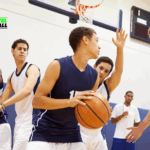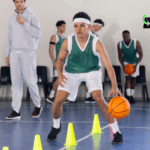Understanding Offensive Approach In Basketball
Understanding offensive approach in basketball involves grasping the fundamental strategies that teams use to score points and effectively utilize their possession time. At its core, the offensive game centers around ball movement, spacing, and player movement without the ball. Successful offenses rely on teamwork and communication to create high-percentage scoring opportunities, whether through fast-paced transitions, set plays, or pick-and-rolls.
Spacing
An essential principle is spacing, which prevents defenders from easily doubling up on the ball handler and opens lanes for drives or passing options. By maintaining effective spacing, players can stretch the defense and create gaps that can be exploited by quick, sharp cuts or drives to the basket.
Timing
Another important element is timing, which involves not only the instantaneous actions of players but also the pacing of the game as a whole. Timing ensures that plays unfold smoothly and exploits defensive lapses or mismatches. The pick-and-roll exemplifies how timing can dismantle a defense, as a well-timed screen can create separation for shooters or open lanes for ball handlers. Additionally, player movement without the ball, including backdoor cuts and off-the-ball screens, is crucial to disrupting the defense and creating open shots.
Effective offenses balance aggression with patience, dynamically reading the defense to choose the optimal moment to make a move or take a shot, and adjusting strategies in response to the game’s flow.
Developing Fundamental Offensive Skills
Developing fundamental offensive skills in basketball is pivotal to mastering the offensive approach.
Dribbling and Footwork
At the core of these skills is ball handling, which allows a player to navigate through defensive pressure with ease. Dribbling with both hands, changing speeds, and executing quick crossovers create opportunities for successful offensive plays. Similarly, footwork is essential, enabling players to maneuver effectively and maintain balance.
Mastering pivoting, jump stops, and the triple-threat position elevates a player’s ability to make decisive moves when on the attack.
Shooting
In addition to ball handling and footwork, shooting is a crucial offensive skill that requires consistent practice to refine technique and build confidence. Developing a reliable shooting form, complete with proper hand placement, foot alignment, and follow-through, allows players to convert scoring opportunities from various distances. Equally significant is the ability to shoot under pressure, a skill that comes with repetition and creating game-like scenarios during practice.
Passing
Passing, too, is a fundamental skill that enhances offensive play by fostering team cohesion and execution. Accurate and timely passes—whether chest, bounce, or overhead—open up scoring chances and dictate the pace of play. Reading defenses and recognizing when to deliver a timely assist further solidify a player’s offensive repertoire. By focusing on these fundamental skills, players lay the groundwork for a versatile and commanding offensive game.
Mastering Offensive Plays And Strategies
Mastering offensive plays and strategies in basketball involves a deep understanding of the game’s dynamics and the ability to effectively execute a variety of tactics on the court. The goal is to create scoring opportunities while maintaining fluidity and unpredictability in attack. The key to mastering offensive plays is the understanding of spacing and movement. Players must be aware of their own positioning as well as that of their teammates to optimize passing lanes and minimize defensive pressure.
Quick and decisive ball movement is essential, allowing for the defense to be stretched and gaps to be exploited.
Pick and Roll
One fundamental aspect of offensive strategy is the pick-and-roll, a play that requires precise timing and communication. This technique, when executed correctly, creates mismatches and open shots.
Off-Ball Screens
Similarly, utilizing off-ball screens can free shooters for open looks or allow for cutting lanes toward the basket. Offensive players must also develop the ability to read defenses, adapting their strategy based on whether the defense is employing man-to-man or zone coverage.
The effectiveness of any offensive play is heavily dependent on the players’ ability to make quick decisions, seamlessly transitioning between set plays and improvisational moves. Beyond physical skills, this requires mental acuity and instinct. Continuous practice, film study, and a comprehensive understanding of opponents’ tendencies are crucial for players to elevate their offensive game to a masterful level.
Enhancing Court Vision And Decision-Making
Enhancing court vision and decision-making is a critical component in mastering the offensive approach in basketball. Players who excel in these areas often become invaluable assets to their teams, as they can perceive and exploit opportunities that others might miss. Developing superior court vision involves an acute awareness of the entire playing area, anticipating the movements of teammates and opponents alike, and understanding the evolving dynamics of the game.
Keep Your Head Up
One way to improve court vision is to practice keeping your head up while dribbling, enabling you to scan the floor and remain alert to developing plays.
Watching Basketball Games
Watching extensive game film can familiarize players with various defensive strategies and common patterns, enhancing their ability to make quick, informed decisions during live play.
Decision-Making
Decision-making, on the other hand, demands not only physical skill but also mental acuity. It requires making split-second choices under pressure, selecting the optimal option from multiple possibilities. Players must evaluate factors such as timing, positioning, the defensive setup, and the strengths and weaknesses of both their teammates and opponents. Effective decision-making often comes from experience, reflection, and a deep understanding of the game’s nuances.
Practice scenarios, such as situational drills and scrimmages, can simulate game-time pressure, allowing players to hone their decision-making skills in a controlled environment. Together, enhanced court vision and decision-making elevate a player’s offensive capability, transforming them into strategic thinkers on the court.
Effective Communication And Teamwork On Offense
Effective communication and teamwork are fundamental components of mastering the offensive approach in basketball. At its core, basketball is a team sport reliant on the synchronized efforts of all five players on the court. To execute successful offensive plays, players must engage in constant communication, both verbally and nonverbally, to ensure coordination and adapt to the dynamic nature of the game.
Verbal Communication
Verbal communication involves calling out plays, signaling when a screen is set, and alerting teammates to open passing lanes or defensive switches. These verbal cues help players maintain awareness of their surroundings and make split-second decisions that can alter the outcome of an offensive possession.
Non-Verbal Communication
Beyond spoken communication, players must develop strong nonverbal communication skills. This includes reading body language, understanding teammates’ tendencies, and responding to subtle movements, such as eye contact or hand signals, that indicate a change in strategy or an open scoring opportunity. Nonverbal communication often separates cohesive teams from those that struggle to find rhythm on offense.
Mutual Trust
Teamwork is further solidified by a mutual trust amongst players, cultivated through practice and shared experiences. When players trust each other’s abilities and decision-making, they are more confident in passing the ball, setting strategic screens, and making collaborative efforts to exploit defensive weaknesses. Ultimately, effective communication and teamwork create a fluid, dynamic offense capable of adapting to challenges and seizing opportunities during a game.
Adapting Offensive Techniques To Opponents
Mastering the offensive approach in basketball requires players to continuously adapt their techniques to exploit the specific weaknesses and tendencies of their opponents. Understanding the defensive strategies that different teams and players employ is crucial for tailoring an offensive approach that maximizes scoring opportunities. Observing how defenders react to different plays can provide insights into their habits, such as favoring a particular side, struggling with speed, or reacting slowly to ball fakes.
Adaptability
Adaptability also involves being versatile with offensive movements and techniques. A player who can only drive to the basket is limited compared to one who can shoot, pass, pivot, and change speeds effectively. This versatility makes it harder for defenders to anticipate and react.
Physical Attributes
Understanding an opponent’s physical attributes is vital. A player with great height may be vulnerable to quicker moves and lower plays, while a smaller, faster defender may struggle with physical, back-to-the-basket plays.
Communication and collaboration with teammates are equally important. By sharing observations and insights during gameplay, players can coordinate dynamic offensive strategies that leverage collective strengths. This team cohesion can be the key to unlocking an opponent’s defensive setup and gaining an advantage, ultimately transforming adaptability into a significant offensive weapon.
Gear up, hit the court, and let your performance do the talking. Master the defensive approach in playing basketball with Next Level Basketball. Call 954-621-8470 to book your first session.




